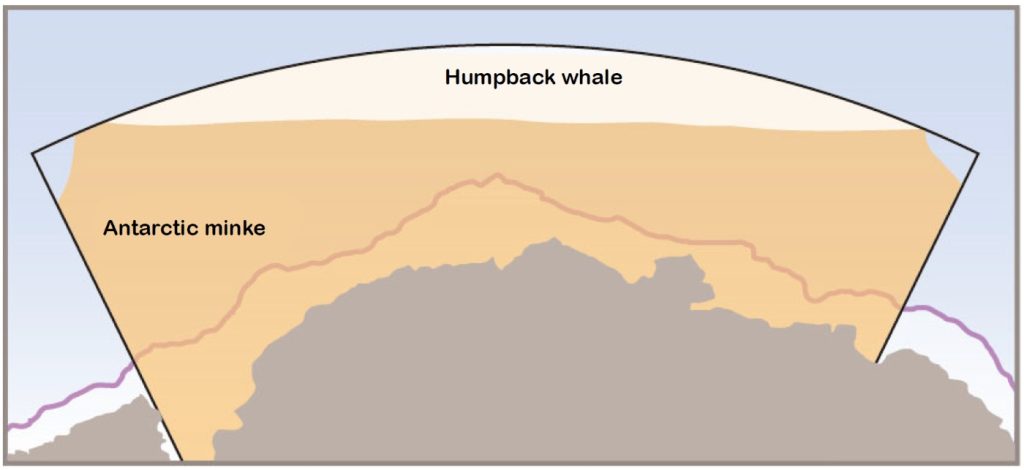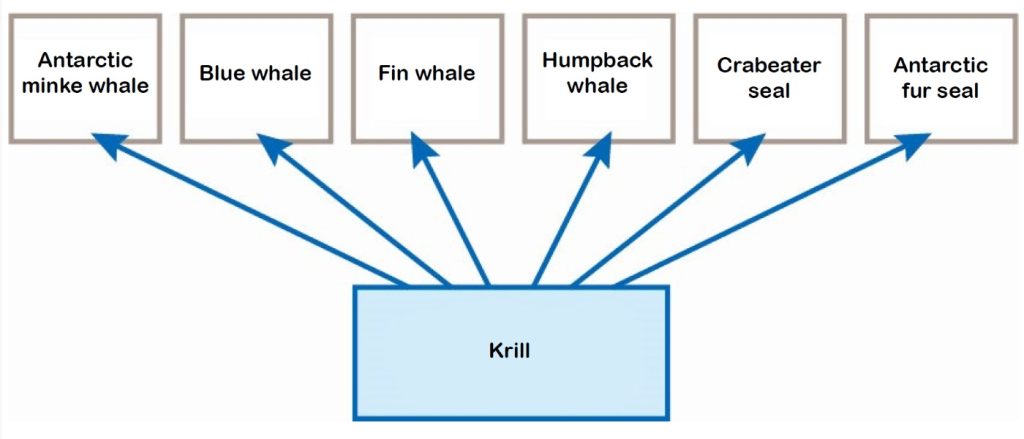Genetics reveals patterns the sea hides. Within each whale species, distinct breeding stocks use separate breeding grounds. Understanding the stock structures of these whales is essential for responsible management.
Japan’s Institute of Cetacean Research is mapping them across the Antarctic and the North Pacific.
In the Antarctic, commercial whaling once emptied the top ranks of the food web. Thereafter, Antarctic minke whales rose on surplus Antarctic krill and reshaped the ecosystem’s species mix. However, as great whales rebound, distributions — and the balance among species — are shifting again. This article traces those shifts.
Antarctic Minke Whale Stock Structure in the Southern Ocean
Under the Japanese Whale Research Program in the Antarctic (JARPA), minke whales were treated as a single species worldwide. Genetic analyses from that work, however, showed the Antarctic minke is distinct from Northern Hemisphere minke whales. It is now recognized as the Antarctic minke whale species.
At least two stocks of these whales migrate into the Southern Ocean feeding grounds. The I-stock occurs in Area III East, Area IV, and western Area V. The P-stock occurs in eastern Area V and western Area VI. Some zones show an overlap between the two stocks (Figure 1).

Humpback Whale Stock Structure
Two breeding stocks of humpback whales also visit the Antarctic survey area and overlap there. The D-stock breeds off the coast of Western Australia. The E-stock breeds around eastern Australia, New Caledonia, and Tonga.
Shifts in Baleen Whale Distribution
The studies show that a sharp rise in abundance is reshaping species’ ranges. Comparative analyses of surging humpback abundance and stable Antarctic minke numbers point to possible competition for prey.
Survey Divisions in the Indo-Pacific Sector of the Southern Ocean
(Graphic ©Suisan Keizai Daily News)

Simplified Distribution Maps in Survey Area IV
(Graphics ©Suisan Keizai Daily News)



Humpback whales were concentrated in the northern part of the survey area in the early period. Then, by the middle period, their range pushed toward the outer edge of the continental shelf. In the late period, it spread along the shelf break across the area.
Meanwhile, as humpbacks broadened their range, Antarctic minke distributions appear to have contracted. The pattern suggests possible competition for foraging areas as humpbacks increased.
Changes in Blubber Thickness
Antarctic minke whales gorge on Antarctic krill at summer feeding grounds. They store the energy as lipids, chiefly in blubber. They then migrate north to lower latitude breeding grounds, where they spend that energy on reproduction.
In a sample of 4,689 individuals, blubber thickness fell by 0.02 centimeters a year, and total fat reserves dropped 17 kilograms over 18 years.
Why? Blubber thickness correlates with the weight of stomach contents, pointing to a possible decline in prey available to Antarctic minke whales. The recovery of great whales may play a role, but the cause remains under study.
What Do They Eat?
Antarctic minke whales feed mainly on Antarctic krill when they are in open Southern Ocean waters. In high latitude embayments such as the Ross Sea, they also eat ice krill.
Their annual krill consumption is estimated at 3.51 to 3.98 million metric tons.
The Southern Ocean ecosystem centers on the abundance of Antarctic krill. Beyond Antarctic minke whales, blue, fin, and humpback whales ー and crabeater seals and Adélie penguins — also depend on it.

Whale Research Program in the Antarctic
JARPA I (1987–2005)
The International Whaling Commission adopted a commercial whaling moratorium in 1982, which was to take effect in 1985. Japan lodged an objection, which it later withdrew. The moratorium became effective in 1986/87. Japan designed the Whale Research Program in the Antarctic after the International Whaling Commission’s 1982 decision, citing uncertainty in the science on whale stocks. It then launched the program in 1987 and continued it until 2005.
Its target species was the Antarctic minke whale. The survey examined:
- abundance, natural mortality, and recruitment,
- the species’ role in the Southern Ocean ecosystem,
- impacts of environmental change on whale stocks, and
- stock-distribution ranges.
JARPA II, (2005–2014)
In phase two of the project, the target species were expanded to include Antarctic minke, fin, and humpback whales.
This expansion of the species scope allowed the study of relationships with other whale species. Its objectives included monitoring the Southern Ocean ecosystem and building interspecific competition models.
In 2014, in a case brought by Australia, the International Court of Justice (ICJ) reviewed the program. While the court recognized some scientific merit, it ruled that, among other reasons, including unmet target sample sizes, the program fell outside the International Convention for the Regulation of Whaling, Article VIII (1).
The program ended that year.
NEWREP-A In the Antarctic (2015-2019)
Thereafter, the New Scientific Whale Research Program, better known as NEWREP-A, was developed as a consequence of the ICJ judgment. It was implemented after expert review and IWC Scientific Committee discussions. NEWREP-A continued from 2015 to 2019.
One aim was to improve the precision of biological and ecological data for Antarctic minke catch-limit calculations under the revision management method, or RMP. Another aim was to build an ecosystem model to study Southern Ocean structure and dynamics.
Antarctic Whale Resource Survey (JASS-A, 2019–present)
Following the NEWREP-A program, Japan developed the Antarctic Whale Resource Survey study (JASS-A). Launched in 2019, it is a continuation of Japan’s non-lethal resource surveys in the Southern Ocean for the sustainable use of whale resources.
JASS-A aims to study the abundance and trends of great whales, and their distribution, migrations, and stock structure.
Beginning with this program, surveys use only non-lethal methods. No whales are caught. Under this program, work is underway to update abundance estimates for the 2010s and 2020s.
For more details, see Geiken Tsushin No 492 (in Japanese.)
(This report is published in cooperation with the Institute of Cetacean Research in Japan. The article was first published in Japanese in the Suisan Keizai Daily News on February 28, 2023. A longer version of the article is available in Japanese at the Whale Town Portal. Let us hear your thoughts in our comments section.)
RELATED:
- Antarctic Whales: Insights from Decades of Research
- Fisheries and Food Security in Japan’s Rich Waters
- Whales in the Japanese Landscape: A Test of Character, Past and Present
Author: Author: Suisan Keizai Daily News

